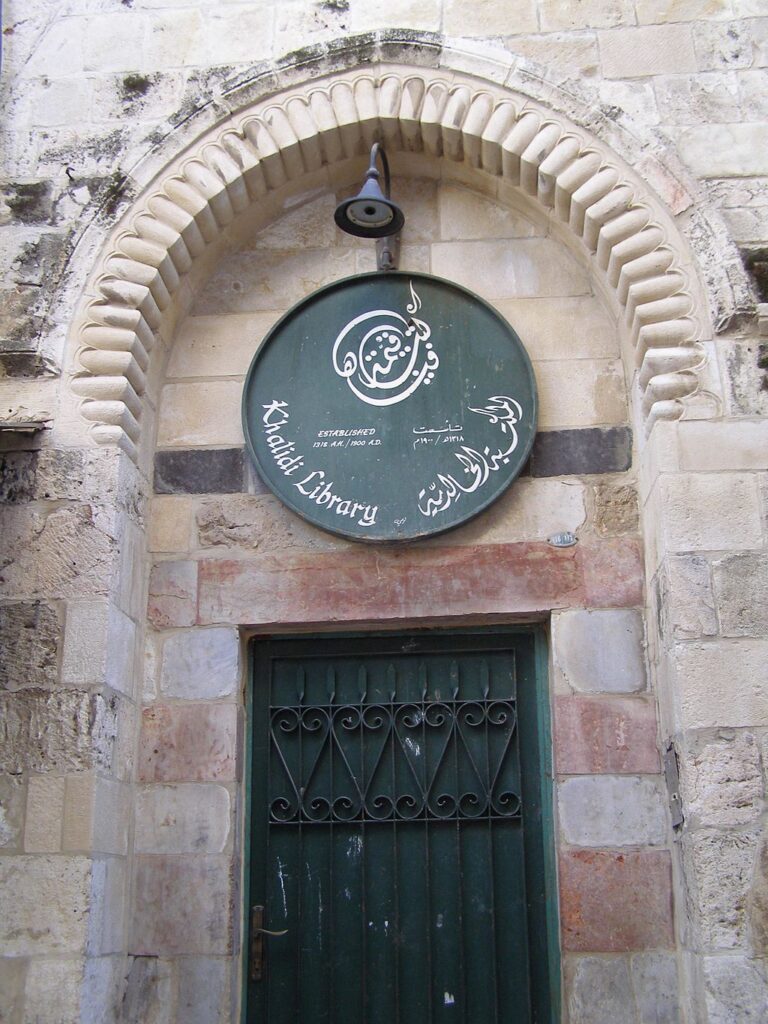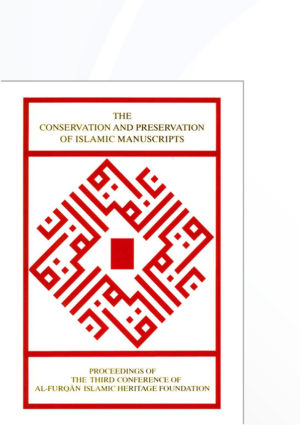Tony Bish
| Article contents: > Introduction > Fragments > Fumigation > Frames > Conclusion |
Introduction

In the autumn of 1986, I was asked by Lawrence Conrad if l could travel to Jerusalem to prepare a Conservation Condition report on the Khālidī Library consisting of approximately 1,200 manuscripts. I arrived in Jerusalem in June 1987, very excited at the prospect of working on a collection which had lain dormant for many years.
The Khālidī family is one of the oldest and most prominent families of Jerusalem; its leading role in the city is attested to as far back as the 12th century AD, and for hundreds of years its members have played important roles in the political, social, and religious life of Jerusalem. As was common in such cases, the various branches and members of the family gradually built up collections of books in manuscript form which were passed down from one generation to the next. In modem times, almost all such collections of any significant size have gradually been dispersed through purchases or acquisitions by national or foreign institutions, or scattered through distribution among a large number of heirs. That of the Khālidīs, however, has moved in exactly the opposite direction, and has survived as a unit.
Fragments
The Khālidī Library is housed in what was once the turba of the Khwarizmian chieftain Ḥusām al-Dīn Barakat Khān, rebuilt on older commercial premises in the late 13th century AD. An unexpected find occurred when an engineer overseeing building work at the library examined the roof timbers and reported that when tiles were lifted, shafts of sunlight streaming into the loft above the ceiling of the library's reading room revealed great masses of paper Some papers and fragments had already been found in the reading room itself, and this new material above the ceiling vastly increased the volume. In all, there are in excess of 20,000 sections, fragments and loose folios from medieval manuscripts. This material was of course in utter disarray, but was surprisingly well preserved. So far, it has been possible to reconstruct a number of important texts. These materials have also, in certain cases, made it possible to fill lacunae in some of the bound manuscripts in the reading room, the point of interest being that the loose materials are definitely related to the manuscripts in the reading room.
Among the numerous fragments: items were found which proved to belong to manuscripts on the shelves of the library. This stressed once more the importance of these fragments and their connection to the bound manuscripts, It was agreed to sort the fragments in stages: they would first be separated into stacks of approximately the same size, then each stack would be further sorted according to style of script, Then each of these "sub-stacks" would be further sorted according to subjects, and from these final stacks it would, We hope, prove possible to reconstitute entire volumes and fill lacunae in the manuscripts. As work proceeded, fragments that proved to be documents rather than literary pieces were set aside separately.
The firm stage, that of sorting the fragments by approximate size, promised to be the most difficult since it involved going through all of the fragments in their state of extreme disarray — many stuck together, others caked with layers of dust and dirt, some crumpled up into fragile balls, and so forth. The task was also extremely unpleasant because only limited ventilation was possible (the breeze would have blown our stacks all round the room). There was almost no relief from the thick clouds of dust raised by the work. In fact the work simply could not have been done without the basic face-masks which had been brought from London.
The fourteen boxes of fragments have now been reduced to four, neatly stacked in different compartments. The next stage will be, as mentioned above, sorting each stack by script. Work will begin on this in the near future. To assist in the reconstruction of these fragments a sheet of folded polyester is used. The largest piece of the fragmentary document is placed between the polyester and held flat. Other fragments are then placed on top of the polyester and checked for uniform damage, text, and content. Although somewhat crude, this is a cheap and remarkably quick method of comparing many fragmentary items.
Fumigation
The manuscripts housed in the reading room were on wooden shelves which reached from floor to ceiling, a distance of 4.5m. They were covered in dust and there was evidence of large scale insect infestation. The first problem was to identify a clean working and storage area, and to remove the manuscripts to it; this was successfully completed by early 1987.
Because of the damage being caused by the insect infestation, fumigation became a matter of some urgency. Due to lack of facilities in the 'Old City' of Jerusalem this proved somewhat difficult, but eventually an individual willing to undertake the work was identified and fumigation commenced. Two smoke generators were used containing the chemical HCH (Hexachlorocyclohexane), trade name Lindane. This is an extremely dangerous substance and should only be handled by those qualified to use it. Judging by the number of dead insects lying everywhere it had obviously worked. Examples of these insects were collected and on examination proved to be Anobidae, a very destructive species of furniture beetle. This pest can live on the cellulose and glutinous material found in paper, cloth, and glue used on old books. It usually lays its eggs along the spine of the book. When the eggs hatch, the larvae eat their way along the spine, attracted by the glue used in the binding process. When this is exhausted, the larvae then begin to eat their way back and forth through the book itself. The damage that can he caused by the furniture beetle is thus quite considerable.
Although initially successful, it soon became apparent that Lindane was not the long term solution. The insect infestation continued to cause problems; several times a year more insects hatch and become a threat to all collections. All insects cannot be excluded from library premises no matter how careful we are. They enter on our clothes, our hair, through cracks in window frames and in many other ways. The only effective deterrent is continuous fumigation by qualified people using professional equipment. Ideally, this should he undertaken twice a year to ensure success. Although the Khālidī Library premises had to be closed for three days and all windows and doors sealed, the fumigation proved to be a very successful operation.
Frames
Verdigris ink was a major problem commonly encountered in the collection. Where rectangular frames have been drawn around illuminated areas, the use of verdigris — a copper ink which simulates gold — acidic chemicals have attacked the paper. In many cases, this has resulted in the illuminated area peeling away from the page. To conserve these areas I make a 'frame' using Spider Facing Tissue which may be colour toned if necessary Simple tears and missing areas are also conserved with Spider Facing Tissue. Research is currently being undertaken, by Polarising Microscopy, to identify the various pigments used on the manuscripts, some of which are extremely fugitive.
Conclusion
All 1,200 manuscripts are now in protective boxes and stored on metal shelving. Although a great deal of work remains to be done with fragments, conservation and binding, much has been achieved over the past eight years. We hope this work will continue until the Khāhidī library can once more open its doors to scholars of Islamic research.
| Source note: This article was published in the following book: The Conservation and Preservation of Islamic Manuscripts, Proceedings of the third conference of Al-Furqān Islamic Heritage Foundation, 18th-19th November 1995 - English version, 1995, Al-Furqān Islamic Heritage Foundation, London, UK, pp. 49-52. Please note that some of the images used in this online version of this article might not be part of the published version of this article within the respective book. |


